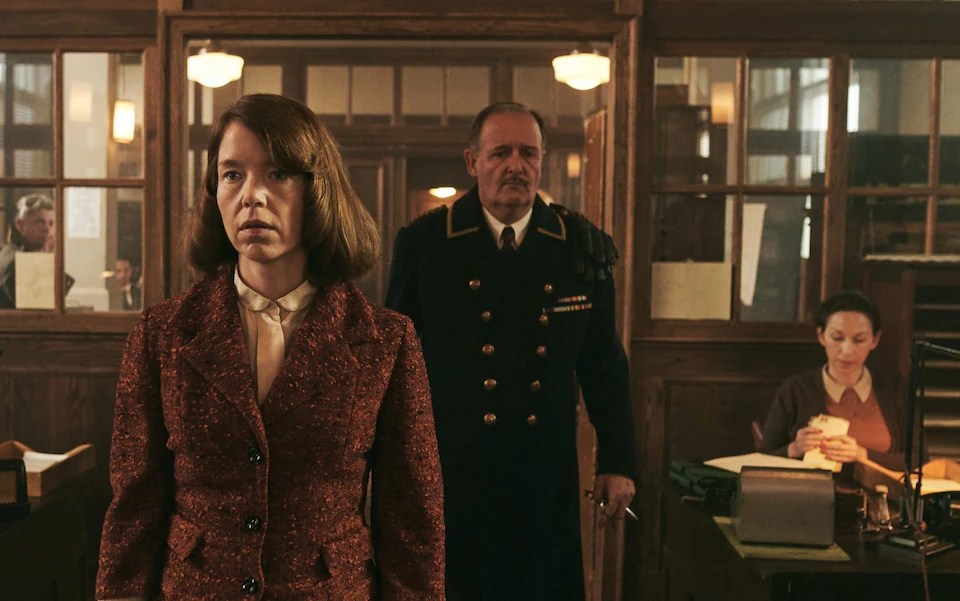The popular historian Ben Macintyre is a fortunate fellow. No sooner has the BBC’s acclaimed adaptation of his account of the SAS’s wartime birth Rogue Heroes wrapped up, than on 8 December ITV launches an equally lavish drama series, A Spy Among Friends based on another of his bestsellers – the story of Soviet super spy and arch traitor Harold ‘Kim’ Philby.
The difficulty with parachuting fictional women into the stories of mid 20th century war and spycraft though is that their presence would have changed everything
Both series largely stick to the facts meticulously recorded by Macintyre and feature real historical figures. Rogue Heroes is populated by square jawed chaps like David Stirling, Jock Lewis and Paddy Mayne who founded the SAS and got their jollies careering round Nazi airstrips blowing up planes. A Spy Among Friends, set in the same era, has goofy upper class SIS/MI6 spooks in suits and bars failing to twig that their chum Kim is a double agent working for Stalin.
There are, however, prominent cast members in both series who do not figure in either the historical record or Macintyre’s books. That is because they never existed. These fictional figures dreamed up by the dramas’ writers are both women. Rogue Heroes has a Free French femme fatale played by Algerian actress Sofia Boutella. Her character beds some of our square-jawed chaps in a bid to extract SAS secrets.
A Spy Among Friends is another excursion around the oft told tale of the Cambridge spies – Philby, Burgess, Maclean, Blunt and Cairncross – but this time with an extra twist of a woman added to the mix. This wholly fictional character, Lily Taylor, an MI5 officer played by Anna Maxwell Martin, has been invented because she ticks so many modish contemporary boxes. She is a working class woman (good). She is intelligent while her public school colleagues working in intelligence are dimly stupid (bad). The trouble is that Lily is not real but a figment of her screenwriting creator’s imagination.
There is no problem about twisting or inventing facts or characters on screen for purposes of dramatic license. The difficulty with parachuting fictional women into the stories of mid 20th century war and spycraft though is that their presence would have changed everything. The history of the SAS and of the Cambridge spies is an overwhelmingly male story and changing that truth to fit our world view today distorts history itself.
There is no getting away from the fact that the early SAS soldiers were a rough, tough, and sometimes downright psychopathic bunch. Defeating Nazism required both physical bravery and brutish violence from those desert warriors. Wartime North Africa was no place for the feminine virtues – even though Dominic West as a cross-dressing British intelligence officer looked delightful in a frock.
Equally, the whole point about the Cambridge spies is that they were bound together by masculine – often homosexual – as well as ideological ties. They were nurtured by the heavily homoerotic atmosphere of their public schools and the university itself, and their guiding motto was Cambridge novelist E.M. Forster’s dictum that if it came to a choice between betraying his country or his friends he ‘hoped he would have the guts to betray his country’. So they did.
There were many women working and fighting in other fields in the secret war against Hitler – breaking Nazi codes at Bletchley Park and dropping into occupied France as SOE agents being but two examples. In the SAS and SIS, the two organisations portrayed in these dramas, however, women were only conspicuous by their absence.
The writer and stars of A Spy Among Friends invoke class as well as sex warfare to justify the invention of a woman character fighting the class war alongside the real ones. Maxwell Martin told the Daily Telegraph that her ‘brilliant’ character was ‘the antithesis of the world she finds herself in… which is toffs’. She adds: ‘We still have an elitist society today but my God, it was really elitist then.’
But it is the toffs themselves who are lacerating themselves in the series. Damian Lewis, who plays Nicholas Elliott, a colleague of Philby who confronts his mentor over his betrayal, was – like Guy Burgess – educated at Eton. In an outburst of extraordinary derision of the class from which he himself sprang Lewis described MI6 to the Telegraph as ‘white, upper class dinosaurs… responsible for two world wars’. (Er, no Damian, that was Kaiser Bill and Hitler respectively – didn’t they teach you history at Eton?).
Series screenwriter Alex Cary – like Philby educated at Westminster School – tells the paper that he invented Lily as an act of self-mortification to purge himself of his privileges: ‘It’s a part of British society that I come from and it’s always something that I’ve been aware of – my privilege and class and all of those things.’
Rather than a forgivable addition to history for dramatic reasons then, A Spy Among Friends looks like yet another exercise in guilt-ridden virtue signalling from a class almost as eaten up with self loathing as Philby and his mates. It is, in its way, yet another betrayal.






Comments